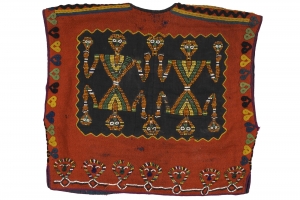TELDAP Collections
| Paiwan short shirt |
|
The Paiwan is Taiwan’s third largest recognized indigenous tribe. The tribe’s distribution is in low mountain areas at between 100 and 1,000 meters in elevation, including the southern branch of the Central Mountain Range, Damumu Mountain (Taivuvu) and southward to the Hengchun Peninsula. In terms of administrative boundaries, the Paiwan tribe inhabits eight townships in Pingtung County including Sandimen, Majia, Taiwu, Laiyi, Chunri, Mudan, Shizi and Manzhou and five townships in Taitung County including Beinan, Jinfeng, Taimali, Daren and Dawu. There are also a small number of Paiwan living in Zhuoxi Township of Hualien County and Sanmin and Taoyuan counties of Kaohsiung County. The Paiwan tribe has a strict social hierarchy that includes the nobility and commoners. Each hierarchical level comes with a unique set of rights and obligations. For example, certain names were only for the use of the upper echelon of society. In addition, those of the common class were not allowed to use certain motifs or patterns on the carved lintels above the door to their homes, on their clothing or on utensils for daily use. These included human head and hundred pace pit viper motifs. Paiwan clothing was made using different methods, styles and designs including weaving (Tjunenun), embroidery (vnetsikan), beading (pinu-luvuts-an), attachment of various decorations (pina-djekets-an) and webbing, etc. The meanings and themes of patterns and decorations are associated with the tribe’s social hierarchy, and can be divided into three types: 1. Symbols of nobility and differentiation of classes. The Paiwan prefer clothing that is comprised of black or blue cotton cloth or flannelette. In addition, they make use of white cotton cloth, red flannelette, black silk fabric or woolen material to complete an article of clothing. The form of this shirt was derived from Chinese-style clothing. The buttons are traditional Chinese style buttons. In general, buttons were not often used on traditional clothing because they could not be easily made. Thus, the Paiwan made use of round copper buttons and flat silver buttons produced by the Chinese. Sometimes, glazed beads were stitched onto clothing. According to field studies by C-L. Chen this type of clothing appeared more recently. There are orange, yellow and green beads stitched onto this shirt, which are colors common among Paiwan glazed beads. Although the practice of stitching beads onto clothing came rather late, there is a long history of glazed beads in the Paiwan material culture and they are considered of great value. Usually, embroidered patterns were determined by the social status of the wearer. In general, human head, human figure, sun and hundred pace pit viper patterns were the most common. Among them, the sun pattern did not appear with much frequency until late in Paiwan history. Older beads that are opaque, solid in color and long were used in combination with transparent, round plastic beads. As glazed beads were traditionally considered precious, plastic was often used as a substitute for them when decorating clothing.
This shirt measures 40 centimeters in length. It is 43 centimeters wide as measured at the hem-line. The openings for the arms are 24 centimeters in length and the collar measures 35 centimeters. This is a typical example of a square-patterned shirt. On the front are three copper buttons. Also on the front, on either side, are square pieces of black cloth measuring 20 centimeters in length and 15 centimeters in width. They are decorated with beaded symmetrical patterns of human heads and partial human figures. On the back is a piece of black cloth measuring 32 centimeters in length and 23 centimeters in width. On this is also a beaded symmetrical pattern of human heads and partial human figures. Along the bottom of the shirt in front are six beaded human head patterns and in the back are seven such patterns. Along the shoulders are stripes and wave patterns made with pieces of cloth. Along the sides and on the front are V shapes also made from pieces of cloth. The inner part is dark blue and the outer part is red. The main material used is linen with beading and decorative cloth patches. Patterns include human heads and partial human figures in symmetrical pairs. In addition, there are rhombuses and V shapes, as well as waves and straight lines. This shirt features a variety of colors including black, blue, white, yellow, green, pink, orange and purple.
Department of Graphic Communications and Digital Publishing, Shih Hsin University Digital archiving project of the Shung Ye Museum of Formosan Aborigines
|













